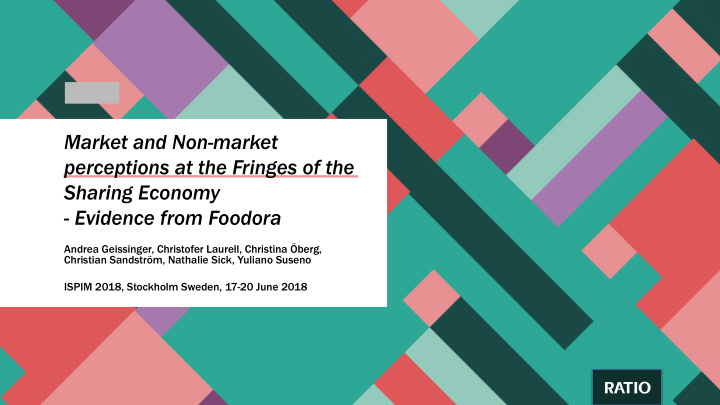



Market and Non-market perceptions at the Fringes of the Sharing Economy - Evidence from Foodora Andrea Geissinger, Christofer Laurell, Christina Öberg, Christian Sandström, Nathalie Sick, Yuliano Suseno ISPIM 2018, Stockholm Sweden, 17-20 June 2018
Background • Different sectors of the economy from taxi to accommodation are currently experiencing institutional turbulence as a result of digital entrepreneurship and the sharing economy (Acquier et al., 2017) • Attention has been directed towards Uber and Airbnb • Less known about the effects of sharing economy platforms in other sectors of the economy Empirically, more research needed about • other sharing economy firms and their effects
Purpose and Research Questions • Previous research suggests that sharing economy offers have consequences in both the marketplace and the institutional domain (Laurell and Sandström, 2016) • Non-market strategy: a firm’s attempts to compete by influencing the institutional and societal context in which it engages in market strategies of economic competition (Lux, Crook, & Woehr, 2011) • Alignment of market strategies with non-market strategies (Baron, 1995) • Lack of integrative work addressing public perceptions in both the market and non-market domain simultaneously The paper aims to assess the ways in which competition currently takes place at the fringes of the sharing economy phenomenon: 1. How is emerging sharing economy actors’ offers perceived in the marketplace? 2. How is emerging sharing economy actors’ offers perceived in the non-market domain of society?
Method For the purpose of this study, the keyword “Foodora” was entered into the service 1 January 2017. Data was thereafter collected up until 31 December 2017, generating a dataset amounting to 3,768 user- generated content covering a time period of 12 months. A total amount of 3,250 remaining user-generated contents. The material was classified into four main themes and thirteen sub-themes relating to the ways in which user-generated content focused its attention to: (1) solely on Foodora, (2) Foodora in relation to one or several competitors, (3) the transformation of the sector as a result of Foodora, and (4) the societal consequences of Foodora.
“It's so worthwhile to Foodora home your food from one block away instead of having to wait for your food... # stopwastingmytime” “ The secret ingredient in the food from […] #Foodora is the tear of the bicyclists.”
Strong Non-Market position Foodora Weak Weak Strong Market position
Analysis and Discussion Foodora’s present position is risky, for numerous reasons: 1. Non-market strategies and public opinion are important for firm survival and may influence the competitive outcome of technological change (Gursez and Ozgan, 2015). 2. Previous research has shown that market and non- market strategies need to be integrated into one overall strategy (e.g. Baron, 1995). 3. If this is not the case, a strong position in the market domain may result in a weakened position in the non- market domain (Funk and Hirschmann, 2014). 4. Previous literature has documented that established interest groups are usually better positioned to influence regulation to their favour than de novo entrants (Lawrence, 1999).
Conclusion Empirically, we contribute by shedding light on sharing economy platforms beyond Uber and Airbnb. Theoretically, we argue that the platform economy, and digital disruption more generally, need to be studied using an integrative approach, i.e. addressing both market and non-market aspects. We welcome further research using this approach.
Recommend
More recommend